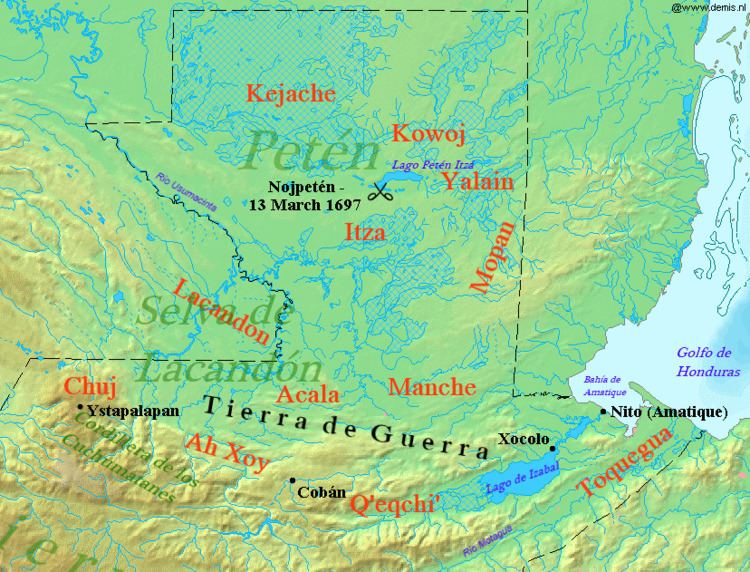 | ||
The Lakandon Ch'ol were a former Ch’ol-speaking Maya people inhabiting the Lacandon Jungle in what is now lowland Chiapas in Mexico and the bordering regions of northwestern Guatemala, along the tributaries of the upper Usumacinta River and the foothills of the Sierra de los Cuchumatanes.
Contents
The Lakandon Ch'ol at contact with the Spanish
The Lakandon Ch'ol of the time of the Spanish conquest should not be confused with the modern Yucatec-speaking Lacandon people occupying the same region. At the time of Spanish contact in the 16th century, the Lacandon Jungle was inhabited by Ch'ol people referred to as Lakam Tun. This name was hispanicised, first to El Acantun, then to Lacantun and finally to Lacandon. The main Lakandon village was situated on an island in Lake Miramar, also referred to as Lakam Tun by the inhabitants. The Lakandons, together with their equally unconquered Itza enemies to the northeast, had an especially warlike reputation among the Spanish.
Later history
Hernán Cortés first heard of the existence of the Lakandon when he was passing through Kejache territory in 1524, although he did not actually contact them. During the 16th century, the Spanish colonial authorities in Verapaz, within the Captaincy General of Guatemala, complained that baptised Maya were fleeing colonial towns in order to find refuge among the independent Lakandon and their Manche Ch'ol neighbours. The first Spanish expedition against the Lakandons was carried out in 1559, commanded by Pedro Ramírez de Quiñones.
At the end of the 16th century, under pressure from the advancing Spanish frontier, the Lakandon Ch'ol abandoned Lakam Tun and withdrew deeper into the forest to the southeast where they founded a new town, Sakb'ajlan, within a wide curve of the Lacantún River. The name of the town translated as "white jaguar". The Lakandons had two other settlements further east, called Map and Peta.
During the course of the 17th century, the Lakandon Ch'ol raided the Guatemalan Highlands to such an extent that it was considered unsafe to travel in the region surrounding San Mateo Ixtatán and Santa Eulalia in the Sierra de los Cuchumatanes, within the colonial Corregimiento de Totonicapán y Huehuetenango administrative division. In response, the colonial authorities placed garrisons in both towns in order to protect the local inhabitants against Lakandon raids, with limited success. The Lakandon Ch'ol traded with the colonial Maya towns of Cobán and Cahabón in Alta Verapaz, receiving quetzal feathers, copal, chile, cotton, salt and Spanish-produced iron tools in exchange for cacao and achiote. From time to time the Spanish launched punitive military expeditions against the Lakandons to try to stabilise the northern frontier of the Guatemalan colony; the largest expeditions took place in 1685 and 1695.
Conversion and resettlement
Franciscan friars Antonio Margil and Melchor López were active among the Lakandon and Manche Ch'ol between 1692 and 1694; they eventually outstayed their welcome and were expelled by the Ch'ol. Most of the Lakandon Ch'ol were forcibly relocated to the Huehuetenango area by the Spanish in the early 18th century. The resettled Lakandon Ch'ol were soon absorbed into the local Maya populations there and ceased to exist as a separate ethnicity. The last known Lakandon Ch'ol were three Indians that were recorded as living in Santa Catarina Retalhuleu in 1769.
